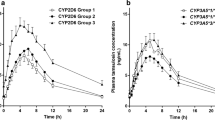Abstract
Purpose
To investigate whether the CYP3A4*1G genetic polymorphism contributes to the variability in CYP3A activity and response to fentanyl.
Methods
One hundred and forty-three gynecologic patients who were scheduled to undergo abdominal total hysterectomy or myomectomy with general anesthesia were enrolled in this study. Intravenous fentanyl patient-controlled analgesia was provided postoperatively for satisfactory analgesia. The degrees of pain at rest during PCA treatment were assessed with visual analog scale. The fentanyl consumption and occurrence of any adverse effects were recorded in the first 24 h postoperatively. CYP3A activity was measured by plasma 1′-hydroxymidazolam-to-midazolam ratio 1 h after intravenous administration of 0.1 mg/kg midazolam. CYP3A4*1G variant allele was genotyped using the polymerase chain reaction–restriction fragment length polymorphism method.
Results
The frequency of the CYP3A4*1G variant allele was 0.269 in 143 Chinese gynecologic patients. The activity of CYP3A4 in patients homozygous for the *1G/*1G variant (0.34 ± 0.15) was significantly lower than that in patients bearing the wild-type allele (*1/*1) (0.46 ± 0.14) or in patients heterozygous for the *1/*1G variant (0.46 ± 0.12) (P < 0.05). The patients with the CYP3A4*1G/*1G genotype needed less fentanyl (227.8 ± 55.2 μg) to achieve pain control than patients carrying the CYP3A4*1/*1 (381.6 ± 163.6 μg) and CYP3A4*1/*1G (371.9 ± 180.1 μg) genotypes (P < 0.05) during the first 24 h postoperatively. There was no significant difference in incidence of adverse events among the different genotype groups (P > 0.05).
Conclusions
CYP3A4*1G genetic polymorphism decreases CYP3A activity and fentanyl consumption for postoperative pain control.


Similar content being viewed by others
References
Gourlay GK, Kowalski SR, Plummer JL et al (1988) Fentanyl blood concentration-analgesic response relationship in the treatment of postoperative pain. Anesth Analg 67:329–337
Labroo RB, Paine MF, Thummel KE et al (1997) Fentanyl metabolism by human hepatic and intestinal cytochrome P450 3A4: implications for interindividual variability in disposition, efficacy, and drug interactions. Drug Metab Dispos 25:1072–1080
Guengerich FP (1999) Cytochrome P-450 3A4: regulation and role in drug metabolism. Annu Rev Pharmacol Toxicol 39:1–17
Ozdemir V, Kalow W, Tang BK et al (2000) Evaluation of the genetic component of variability in CYP3A4 activity: a repeated drug administration method. Pharmacogenetics 10:373–388
Evans WE, McLeod HL (2003) Pharmacogenomics–drug disposition, drug targets, and side effects. N Engl J Med 348:538–549
Fukushima-Uesaka H, Saito Y, Watanabe H et al (2004) Haplotypes of CYP3A4 and their close linkage with CYP3A5 haplotypes in a Japanese population. Hum Mutat 23:100
Du J, Yu L, Wang L et al (2007) Differences in CYP3A41G genotype distribution and haplotypes of CYP3A4, CYP3A5 and CYP3A7 in 3 Chinese populations [letter]. Clin Chim Acta 383:172–174
Gao Y, Zhang LR, Fu Q (2008) CYP3A4*1G polymorphism is associated with lipid-lowering efficacy of atorvastatin but not of simvastatin. Eur J Clin Pharmacol 64:877–882
Du J, Zhang A, Wang L et al (2009) Relationship between response to risperidone, plasma concentrations of risperidone and CYP3A4 polymorphisms in schizophrenia patients. J Psychopharmacol. doi:10.1177/0269881109104932
Woodhouse A, Mather LE (2000) The minimum effective concentration of opioids: a revisitation with patient controlled analgesia fentanyl. Reg Anesth Pain Med 25:259–267
Grass JA (2005) Patient-controlled analgesia. Anesth Analg 101:S44–S61
Kanazawa H, Okada A, Igarashi E et al (2004) Determination of midazolam and its metabolite as a probe for cytochrome P450 3A4 phenotype by liquid chromatography-mass spectrometry. J Chromatogr A 1031:213–218
Thummel KE, Wilkinson GR (1998) In vitro and in vivo drug interactions involving human CYP3A. Annu Rev Pharmacol Toxicol 38:389–430
Zhu B, Liu ZQ, Chen GL et al (2003) The distribution and gender difference of CYP3A activity in Chinese subjects. Br J Clin Pharmacol 55:264–269
Du J, Xing Q, Xu L et al (2006) Systematic screening for polymorphisms in the CYP3A4 gene in the Chinese population. Pharmacogenomics 7:831–841
Streetman DS, Bertino JS Jr, Nafziger AN (2000) Phenotyping of drug-metabolizing enzymes in adults: a review of in-vivo cytochrome P450 phenotyping probes. Pharmacogenetics 10:187–216
Thummel KE, Shen DD, Podoll TD et al (1994) Use of midazolam as a human cytochrome P450 3A probe: II. Characterization of inter and intraindividual hepatic CYP3A variability after liver transplantation. J Pharmacol Exp Ther 271:557–566
Villeneuve JP, L'Ecuyer L, De Maeght S et al (2000) Prediction of cyclosporine clearance in liver transplant recipients by the use of midazolam as a cytochrome P450 3A probe. Clin Pharmacol Ther 67:242–248
Kharasch ED, Whittington D, Hoffer C (2004) Influence of hepatic and intestinal cytochrome P4503A activity on the acute disposition and effects of oral transmucosal fentanyl citrate. Anesthesiology 101:729–737
Hu YF, Tu JH, Tan ZR et al (2007) Association of CYP3A4*18B polymorphisms with the pharmacokinetics of cyclosporine in healthy subjects. Xenobiotica 37:315–327
Jin M, Gock SB, Jannetto PJ et al (2005) Pharmacogenomics as molecular autopsy for forensic toxicology: genotyping cytochrome P450 3A4*1B and 3A5*3 for 25 fentanyl cases. J Anal Toxicol 29:590–598
Acknowledgments
This work was supported by grants from Medical Science and Technology Research Projects of Henan Province (No.200703018). The authors acknowledge the technical assistance of Shu-Sheng Zhang (Department of Chemistry, Zhengzhou University) in carrying out the LC-MS analysis.
Author information
Authors and Affiliations
Corresponding author
Rights and permissions
About this article
Cite this article
Zhang, W., Chang, YZ., Kan, QC. et al. CYP3A4*1G genetic polymorphism influences CYP3A activity and response to fentanyl in Chinese gynecologic patients. Eur J Clin Pharmacol 66, 61–66 (2010). https://doi.org/10.1007/s00228-009-0726-4
Received:
Accepted:
Published:
Issue Date:
DOI: https://doi.org/10.1007/s00228-009-0726-4




